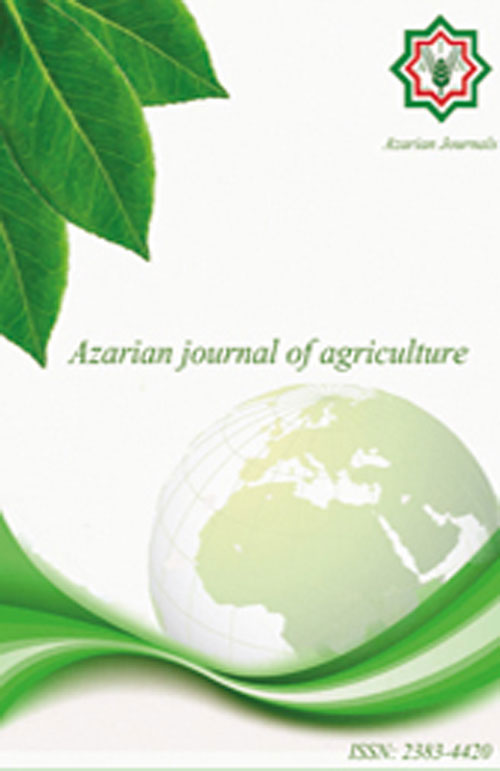فهرست مطالب

Azarian Journal of Agriculture
Volume:6 Issue: 5, Oct 2019
- تاریخ انتشار: 1398/09/23
- تعداد عناوین: 4
-
Pages 112-120
Twenty-nine potato varieties released by Bangladesh Agricultural Research Institute (BARI) were characterized at Breeder Seed Production Centre (BSPC), Debigonj, Bangladesh in 2012-13 and 2013-14 based on the Potato Descriptor IBPGR. Quantification of variability for each character done by Shannon-Weaver Diversity Index was subjected to Principal Component Analysis (PCA), Principal Coordinate Analysis (PCO) and Cluster Analysis. The qualitative characters exhibited low variation while the quantitative characters showed high variation. The Pooled values showed medium variability (0.596). The genotypes were grouped into five clusters. Cluster II had thirteen genotypes, while cluster IV and V had two each. The highest inter-cluster distance was observed between II and IV, while the lowest was III and V. The highest intra-cluster distance was found in cluster I. The inter-genotype distance was the highest between BARI Alu-22 and BARI Alu-41, and the lowest was between BARI Alu-42 and BARI Alu-34. The varieties of cluster IV earned the highest mean value for days to 80% emergence, foliage coverage, plant vigor, primary stem/hill, secondary leaflet and primary leaflet pairs. First four principal components accounted for 93.35% of the total variation. From the scree plot, four sample principal components effectively summarized the total variance. Results of PCA showed a reduction of the sixteen original variables into four linear values. The first principal components (PC1) can be considered as plant height and leaf, indicated by high loadings for plant height at 60 days after planting (DAP) (0.983), leaf length (0.133) and leaf width (0.099).
Keywords: Characterization, Cluster analysis, Morphology, Potato -
Pages 121-128
A field experiment on “Performance of maize hybrids as influenced by establishment methods and planting density” was accomplished at research farm of National Maize Research Program (NMRP), Rampur, Chitwan, Nepal during rabi season of 2015/16. The experiment was laid out in strip-split plot design with three replications consisting of two hybrids as horizontal factor (Rampur hybrid 4 and Rampur hybrid 6), two tillage methods as vertical factors (zero and conventional tillage) and four plant populations as sub-sub plot factors (55.555, 69.444, 85.470 and 1.01.010 plants ha-1). Both maize hybrids (Rampur hybrid 4 and Rampur hybrid 6) produced similar grain yield (5.88 and 6.11 t ha-1, respectively). Similarly, both tillage methods i.e. zero and conventional tillage also produced similar grain yield (6.25 t ha-1 and 5.74 t ha-1, respectively). Beside this, the plant population showed significant effect on grain yield of maize hybrids. Significantly higher grain yield (6.54 t ha-1) was obtained from the population of 85.470 plants ha-1 than 55.555 (5.31 t ha-1) and 69.444 (5.92 t ha-1) plants ha-1 but remained at par with 1.01.010 plants ha-1 (6.21 t ha-1). Both hybrid does not differ statistically in respect to grain yield due to tillage method but produce higher yield at higher planting density than low planting density.
Keywords: Crop geometry, establishment method, phenology, plant population, yield attributes -
Pages 129-138
The Algerian steppe suffered since several decades a serious problem of desertification, under the combined effect of anthropogenic and natural factors. The Djelfa region, like other steppe regions, is affected by this threat. This study aims to quantify the effects of desertification on the different components of the ecosystem in 11 stations located geographically in the Djelfa region. The floristic analysis identified 153 species belonging to 40 families and 110 genera’s. The Edaphic study showed that the studied soils were characterized by high levels of sand and limestone, and low levels of organic matter. In terms of correlations, we find that electrical conductivity decreases when the coarse sand rate increases. The coverage rate of the therophytes is well correlated with the Shannon index with r = 0.89 and the specific diversity with r = 0.74. The equitability index is correlated with chaméphytes and hemicryptophytes species, respectively with r = 0.75 and 0.62. Concerning the basal coverage parameters, there are no functional relationships between the variables forming this group except stone and block rates with a correlation coefficient of r = 0.69.
Keywords: Desertification, Djelfa, floristic analysis, edaphic study -
Pages 139-145
The current study was aimed to investigate the effect of acetylsalicylic acid on pigeon birds. For this purpose healthy pigeons of different weights were randomly selected from Bio-Park University of Malakand and then placed it in different groups on the basis of their weighs. To observe the effect, different doses of acetylsalicylic acid were administered orally to each group of pigeons except one group which was kept as unmedicated (control group). Blood samples were collected from individual pigeon of each group periodically i.e. before medication, during medication and after medication and were analyzed for glucose, cholesterol, alanine amino tranferase (ALT) and uric acid. Blood hematology was also performed for each individual pigeon from all the groups. A significant decrease was observed in glucose and ALT level, while the cholesterol and uric acid level was increased. Likewise to glucose, reasonable increase was observed in total red blood cells count (TRBCs), Hematocrit value (HCT), Mean corpuscular volume (MCV), Mean corpuscular hemoglobin (MCH), Mean corpuscular Hemoglobin concentration (MCHC) and platelets count, while the Hemoglobin (Hb%) and total leukocyte count (TLC) level was decrease. Overall huge toxic effect of acetylsalicylic acid was recorded in pigeons; therefore it should be used carefully in veterinary medicines especially for the treatment of temperature and pain in game birds.
Keywords: Acetylsalicylic acid, Blood biochemistry, Blood hematology, pigeon, Toxicity

